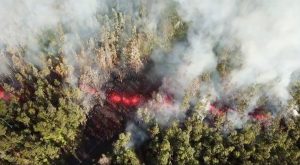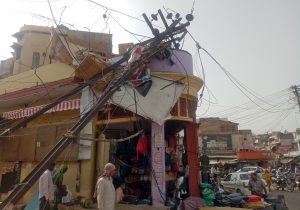
(Reuters) – Hundreds of people were under an evacuation order on Friday after the Kilauea Volcano on Hawaii’s Big Island came to life, belching ash into the sky and spewing fountains of lava in a residential area, officials said.

Lava emerges from the ground after Kilauea Volcano erupted, on Hawaii’s Big Island May 3, 2018, in this still image taken from video obtained from social media. Jeremiah Osuna/via REUTERS
The volcano, one of five on the island, erupted on Thursday after a series of earthquakes over the last couple of days, including a 5.0 tremor earlier in the day, the U.S. Geological Survey reported on its website.
Residents in the Puna communities of Leilani Estates and Lanipuna Gardens subdivisions, home to about 1,700 people, were ordered to evacuate after public works officials reported steam and lava spewing from a crack, according to the county’s Civil Defense Agency.
Two emergency shelters were opened to take in evacuees, the Civil Defense Agency said, while Governor David Ige activated the Hawaii National Guard to provide emergency response help.
“Please be alert and prepare now to keep your family safe,” he said on Twitter to residents living near the volcano.
No injuries or deaths were reported.
Resident Ikaika Marzo told Hawaii News Now that he saw “fountains” of lava as high as 125 feet (38 m). Other residents also told the news network that they smelled burning brush and heard tree branches snapping.

Lava spurts from the ground as emergency vehicles block a road near Kilauea Volcano after it erupted, on Hawaii’s Big Island May 3, 2018, in this still image taken from video obtained from social media. Maija Stenbeck/via REUTERS
The Hawaii Fire Department reported extremely high levels of dangerous sulfur dioxide gas detected in the evacuation area, the Civil Defense Agency said.
Footage from a drone aired on the Hawaii News Now website showed lava incinerating trees as it crept near structures.
A 492-foot-long (150 m) fissure erupted with lava for about two hours in Leilani Estates at about 5:30 p.m. local time, the Hawaii Volcano Observatory said on its website.
Lava, which can reach temperatures of about 2,100 Fahrenheit (1,150 Celsius), spread less than about 10 m (33 ft) from the fissure, the observatory said.
“The opening phases of fissure eruptions are dynamic and uncertain. Additional erupting fissures and new lava outbreaks may occur,” it said.
A plume of red ash rose from the volcano’s Pu’u ‘O’o vent high into the sky over the island, according to photos on social media.
The Puna Geothermal plant was shutting down, according to local media, while Hawaii Electric Light said crews were disconnecting power in the areas impacted by the active lava flow.
The Kilauea Volcano has been erupting nearly continuously for more than three decades. Lava flows from the volcano have covered 48 square miles (125 sq km), according to the U.S. Geological Survey.
Local officials closed volcano viewing areas while a portion of the Hawaii Volcanoes National Park was also closed.
(Reporting by Brendan O’Brien in Milwaukee; Editing by Kevin Liffey and Peter Graff)









